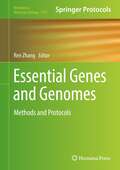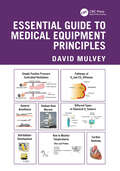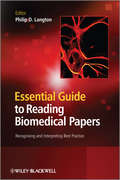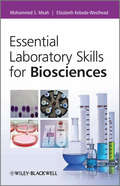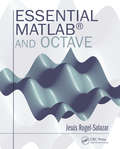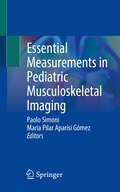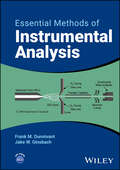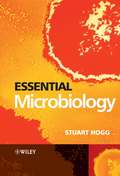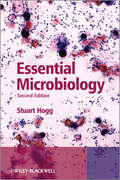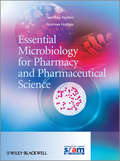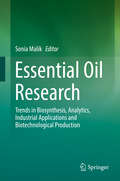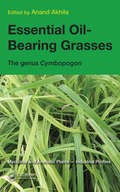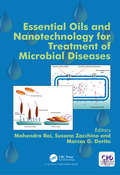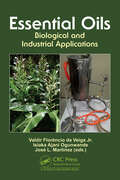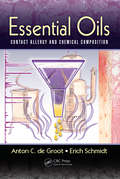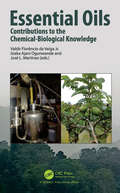- Table View
- List View
Essential Forensic Medicine (Essentials of Forensic Science)
by Peter VanezisProvides an invaluable distillation of key topics in forensic medicine for undergraduate, masters, and postgraduate students Essential Forensic Medicine covers the broad area of the forensic medical sciences, delivering core knowledge in the biomedical sciences, and the law and ethics surrounding them. Concise, accessible chapters cover a wide range of topics from basic forensic identification and examination techniques to forensic toxicology and psychiatry. Written by internationally-recognized experts in the field, this authoritative guide offers complete chapter coverage of the legal system, courts, and witnesses; investigation of the deceased and their lawful disposal; and the duties of a registered medical practitioner and the General Medical Council. It instructs readers on the general principles of scene examination and the medico-legal autopsy including how to interpret the many kinds of injuries one can suffer—including those from blunt impact and sharp force, firearms and explosives, asphyxia and drowning. Further chapters cover sexual offences, child abuse, and using DNA in human identification, mental health, alcohol and drug abuse. A fresh, accessible, up to date textbook on forensic medicine Written by a well-known experts with decades of experience in the field Includes numerous figures and tables, and detailed lists of key information Features numerous case studies to reinforce key concepts and ideas explored within the book Helps students to prepare for examinations and enables practitioners to broaden their understanding of the discipline Part of the “Essential Forensic Science” series, Essential Forensic Medicine is a highly useful guide for advanced undergraduate students, master’s students, and new practitioners to the field.
Essential Forensic Pathology: Core Studies and Exercises
by Gilbert CorriganA myriad of different scenarios await those entering the field of forensic pathology, ranging from gunshot wounds to asphyxiation to explosives to death from addiction. Essential Forensic Pathology: Core Studies and Exercises helps prepare pathologists in training by establishing what they must know about the most common death scenes they will enco
Essential Genes and Genomes: Methods and Protocols (Methods in Molecular Biology #2377)
by Ren ZhangThis book provides state-of-the-art information on gene essentiality screenings in a wide variety of organisms, i.e. screening for protein-coding genes and other genomic elements that are required by an organism to survive under specific conditions. With a focus on the two techniques that have revolutionized the field, the collection begins with chapters employing CRISPR/Cas9-based approaches followed by Tn-seq-based approaches, but later chapters also delve into other techniques for exploring essential genes, such as bioinformatics methods. Written for the highly successful Methods in Molecular Biology series, chapters include introductions to their respective topics, lists of the necessary materials and reagents, step-by-step, readily reproducible laboratory protocols, and tips on troubleshooting and avoiding known pitfalls. Comprehensive and authoritative, Essential Genes and Genomes: Methods and Protocols is an ideal guide for researchers attempting to strip genetics down to its fundamentals.
Essential Guide to Medical Equipment Principles
by David MulveyThis book addresses the needs of new clinical engineers, junior nurses, medics and operating department practitioners (ODPs) with regard to the fundamentals of many of the standard medical devices they will encounter in a hospital environment. The book can be used for both self-directed learning and also in a classroom environment as a textbook.Essential Guide to Medical Equipment Principles introduces and provides the principles behind many of the common medical devices and equipment used within a modern hospital. Each of the seven chapters is designed to cover a particular type of medical device such as mechanical ventilators along with the physiology that must be understood in order to make sense of their application and engineering concepts. This fundamental knowledge will enable the reader to progress further in the years to come. The author uses diagrams throughout the book to allow the reader to get the most from the text and ensure that the most essential information is understood. It offers a comprehensive understanding of the physiological and engineering principles underlying medical equipment.This book is intended for new technicians and engineers entering the clinical engineering field but can also be a valuable resource for a broader range of healthcare professionals, including operating department practitioners, neonatal unit practitioners, intensive care unit practitioners and other medical equipment users. With suppliers, manufacturers and in-hospital training, it will enable them to become safe and competent in the use and application of medical devices and equipment.
Essential Guide to Reading Biomedical Papers
by Philip D. LangtonEssential Guide to Reading Biomedical Papers: Recognising and Interpreting Best Practice is an indispensable companion to the biomedical literature. This concise, easy-to-follow text gives an insight into core techniques and practices in biomedical research and how, when and why a technique should be used and presented in the literature. Readers are alerted to common failures and misinterpretations that may evade peer review and are equipped with the judgment necessary to be properly critical of the findings claimed by research articles. This unique book will be an invaluable resource for students, technicians and researchers in all areas of biomedicine. Allows the reader to develop the necessary skills to properly evaluate research articlesCoverage of over 30 commonly-used techniques in the biomedical sciences Global approach and application, with contributions from leading experts in diverse fields
Essential Laboratory Skills for Biosciences
by Mohammed Meah Elizabeth Kebede-WestheadEssential Laboratory Skills for Biosciences is an essential companion during laboratory sessions. It is designed to be simple and give clear step by step instructions on essential techniques, supported by relevant diagrams. The book includes the use of particular equipment and how to do simple calculations that students come across regularly in laboratory practicals.Written by experienced lecturers this handy pocket book provides:Simple to follow laboratory techniquesClear use of diagrams and illustrations to explain techniques, procedures and equipmentStep by step worked out examples of calculations including concentrations, dilutions and molaritySuitable for all first year university students, the techniques in the book will also be useful for postgraduate and final year project students and enhance the practical and theoretical knowledge of all those studying bioscience related subjects.
Essential Laboratory Skills for Biosciences
by Mohammed Meah Elizabeth Kebede-WestheadEssential Laboratory Skills for Biosciences is an essential companion during laboratory sessions. It is designed to be simple and give clear step by step instructions on essential techniques, supported by relevant diagrams. The book includes the use of particular equipment and how to do simple calculations that students come across regularly in laboratory practicals. Written by experienced lecturers this handy pocket book provides: Simple to follow laboratory techniques Clear use of diagrams and illustrations to explain techniques, procedures and equipment Step by step worked out examples of calculations including concentrations, dilutions and molarity Suitable for all first year university students, the techniques in the book will also be useful for postgraduate and final year project students and enhance the practical and theoretical knowledge of all those studying bioscience related subjects.
Essential MATLAB and Octave
by Jesus Rogel-SalazarLearn Two Popular Programming Languages in a Single VolumeWidely used by scientists and engineers, well-established MATLAB and open-source Octave are similar software programs providing excellent capabilities for data analysis, visualization, and more. By means of straightforward explanations and examples from different areas in mathematics, engine
Essential Mathematics and Statistics for Forensic Science
by Craig AdamThis text is an accessible, student-friendly introduction to the wide range of mathematical and statistical tools needed by the forensic scientist in the analysis, interpretation and presentation of experimental measurements.From a basis of high school mathematics, the book develops essential quantitative analysis techniques within the context of a broad range of forensic applications. This clearly structured text focuses on developing core mathematical skills together with an understanding of the calculations associated with the analysis of experimental work, including an emphasis on the use of graphs and the evaluation of uncertainties. Through a broad study of probability and statistics, the reader is led ultimately to the use of Bayesian approaches to the evaluation of evidence within the court. In every section, forensic applications such as ballistics trajectories, post-mortem cooling, aspects of forensic pharmacokinetics, the matching of glass evidence, the formation of bloodstains and the interpretation of DNA profiles are discussed and examples of calculations are worked through. In every chapter there are numerous self-assessment problems to aid student learning.Its broad scope and forensically focused coverage make this book an essential text for students embarking on any degree course in forensic science or forensic analysis, as well as an invaluable reference for post-graduate students and forensic professionals.Key features:Offers a unique mix of mathematics and statistics topics, specifically tailored to a forensic science undergraduate degree.All topics illustrated with examples from the forensic science discipline.Written in an accessible, student-friendly way to engage interest and enhance learning and confidence.Assumes only a basic high-school level prior mathematical knowledge.
Essential Measurements in Pediatric Musculoskeletal Imaging
by Paolo Simoni Maria Pilar Aparisi GómezThis practical guide presents an up-to-date, comprehensive yet concise collection of the most frequently used measurements in musculoskeletal studies carried out in children and adolescents through the different radiological modalities.The book covers the measurements applied on various anatomical regions in a succinct and easy-to-use structure, with additional chapters dedicated to specific techniques and focused evaluations. It provides radiological images, informative drawings, and diagrams to describe each measurement and explain its applications and role in specific diseases. Also, the book identifies potential difficulties regarding positioning and techniques and offers tips to avoid misinterpretation.The book is a handy reference for everyday use and helps practitioners evaluate pediatric musculoskeletal studies by providing precise instructions on how to perform accurate measurements and interpret them to obtain an accurate diagnosis.
Essential Methods of Instrumental Analysis
by Frank M. Dunnivant Jake W. GinsbachIntuitively organized textbook aligned to common analytical instrumentation courses for undergraduate students Through an analytical approach, Essential Methods of Instrumental Analysis provides an expansive overview of common instruments and methods and their applications for undergraduate students, integrating experimental protocols with real result examples to deliver a well-rounded understanding of the inner workings of the instruments and enabling students to evaluate the success of their experiments and create scientific figures. In addition to detailed coverage of specific instruments, the book discusses analytical laboratory practices, instrument maintenance, statistics, and real-world lab experiments with previous student results. Each analytical method section includes extensive sample preparation information, rather than a simple stand-alone chapter offering generic discussions not connected to specific methods. This book conveniently organizes content by analyte class (inorganic and organic) in a way that is intuitive to a student and aligned with relevant courses. Ancillaries including .mp4 videos, instructor PowerPoint slides, and animations are included on a companion website. Written by an experienced professor and tested and refined over years in his courses since 2008, Essential Methods of Instrumental Analysis includes information on sample topics such as: Proper laboratory protocols for analytical instrumentation, covering chemical reagents, glassware, calibration techniques, and figures of meritOptical physics, covering the interaction of electromagnetic radiation with instrument components and sample molecules, relaxation processes, reflection, diffraction, dispersion, and refractionFlame atomic absorption and flame emission spectrometry, covering optical radiation sources, mirrors, choppers, burner heads, and doppler broadeningGas and liquid chromatography, covering gaseous, liquid, soil-sediment, and biological samples, analyte recovery, chromatography theory, injectors, columns and ovens, common detectors, and mass spectrometers Focusing on contrasts and comparisons across multiple types of instruments in a way distinct from similar texts, Essential Methods of Instrumental Analysis is an essential textbook for students in advanced undergraduate courses in related programs of study.
Essential Microbiology
by Stuart HoggEssential Microbiology 2nd Edition is a fully revised comprehensive introductory text aimed at students taking a first course in the subject. It provides an ideal entry into the world of microorganisms, considering all aspects of their biology (structure, metabolism, genetics), and illustrates the remarkable diversity of microbial life by devoting a chapter to each of the main taxonomic groupings. The second part of the book introduces the reader to aspects of applied microbiology, exploring the involvement of microorganisms in areas as diverse as food and drink production, genetic engineering, global recycling systems and infectious disease. Essential Microbiology explains the key points of each topic but avoids overburdening the student with unnecessary detail. Now in full colour it makes extensive use of clear line diagrams to clarify sometimes difficult concepts or mechanisms. A companion web site includes further material including MCQs, enabling the student to assess their understanding of the main concepts that have been covered.This edition has been fully revised and updated to reflect the developments that have occurred in recent years and includes a completely new section devoted to medical microbiology. Students of any life science degree course will find this a concise and valuable introduction to microbiology.
Essential Microbiology
by Stuart HoggEssential Microbiology 2nd Edition is a fully revised comprehensive introductory text aimed at students taking a first course in the subject. It provides an ideal entry into the world of microorganisms, considering all aspects of their biology (structure, metabolism, genetics), and illustrates the remarkable diversity of microbial life by devoting a chapter to each of the main taxonomic groupings. The second part of the book introduces the reader to aspects of applied microbiology, exploring the involvement of microorganisms in areas as diverse as food and drink production, genetic engineering, global recycling systems and infectious disease. Essential Microbiology explains the key points of each topic but avoids overburdening the student with unnecessary detail. Now in full colour it makes extensive use of clear line diagrams to clarify sometimes difficult concepts or mechanisms. A companion web site includes further material including MCQs, enabling the student to assess their understanding of the main concepts that have been covered. This edition has been fully revised and updated to reflect the developments that have occurred in recent years and includes a completely new section devoted to medical microbiology. Students of any life science degree course will find this a concise and valuable introduction to microbiology.
Essential Microbiology for Pharmacy and Pharmaceutical Science
by Geoff Hanlon Norman HodgesThis text is an essential study guide for undergraduates studying microbiology modules on degree courses in pharmacy and the pharmaceutical sciences. Written by two pharmacists each with over 30 years experience of teaching, research and publishing in pharmaceutical microbiology, it distills the subject down into the essential elements that pharmacists and pharmaceutical scientists need to know in order to practice their profession, and it covers all the microbiology components of the Royal Pharmaceutical Society's indicative syllabus that is at the heart of every UK pharmacy degree.Much of the applied microbiology that a pharmacist or pharmaceutical scientist needs to know is unique: topics like the manufacture of microbiologically sterile medicines and their subsequent protection against microbial contamination and spoilage, the detection of hazardous microorganisms in medicines and antibiotics' manufacture and assay are all covered here. Essential Microbiology for Pharmacy and Pharmaceutical Science Students displays material in an easy to-digest format and concepts are explained using diagrams, tables and pictures wherever possible. The book contains an extensive self-assessment section that includes typical multiple choice, short answer and essay-style examination questions, and a companion website to further test your knowledge from a selection of questions along with further links to relevant sites.
Essential Neuropsychology: A Concise Handbook for Adult Practitioners
by Jonathan DeRightThe goal of this book is to provide brief-but-comprehensive information that can aid in rapid differential diagnosis and allow for more thorough follow-up if needed. This guide is intended to fit easily into the pocket of a lab coat or on your desk, giving readers an efficient way to find information about a specific disease or disorder to prepare for an upcoming case. The book is divided into two parts: Part 1 involves general psychometric and reference information including score classifications, formulas for score conversion, likelihood chaining, and reliable change, psychometric data for stand-alone and embedded PVTs, and the effects of common medications on cognition. Part 2 of the book is organized alphabetically by disease or disorder to promote quick searching, and each chapter provides straightforward information including definitions, subtypes, etiology, epidemiology, course, diagnostic criteria, expectations for test results, and links to more comprehensive sources. Whenever possible, information is gathered through up-to-date literature and high quality pubilcations such as systematic reviews or meta-analyses. Helpful references are provided for more extensive follow-up or further reading.
Essential Oil Research: Trends in Biosynthesis, Analytics, Industrial Applications and Biotechnological Production
by Sonia MalikThis book highlights the advances in essential oil research, from the plant physiology perspective to large-scale production, including bioanalytical methods and industrial applications. The book is divided into 4 sections. The first one is focused on essential oil composition and why plants produce these compounds that have been used by humans since ancient times. Part 2 presents an update on the use of essential oils in various areas, including food and pharma industries as well as agriculture. In part 3 readers will find new trends in bioanalytical methods. Lastly, part 4 presents a number of approaches to increase essential oil production, such as in vitro and hairy root culture, metabolic engineering and biotechnology. Altogether, this volume offers a comprehensive look at what researchers have been doing over the last years to better understand these compounds and how to explore them for the benefit of the society.
Essential Oil-Bearing Grasses: The genus Cymbopogon
by Anand AkhilaWhen enjoying a southeast asian soup or cup of herbal tea, we are really savoring the flavor of lemongrass. Similarly, the sweet aroma of mosquito-repelling lotions comes from the citronella oil present in them. Fine perfumes, candles, and herbal pillows with the pleasing smell of rose are often in fact scented with palmarosa. Providing an in-depth
Essential Oils Desk Reference (4th edition)
by The Editors at Essential Science PublishingAn extraordinary, definitive work on the therapeutic value of essential oils, including their background, chemistry, safety; single oils; blends and massage oils; supplements and hormone therapy; personal care; animal care; VitaFlex, Raindrop and Auuricular; cleansing and dietary programs; and personal usage reference.
Essential Oils and Nanotechnology for Treatment of Microbial Diseases
by Mahendra Rai Susana Zacchino Marcos DeritaThere has been emergence of multidrug resistance problem all over the world due to overuse or underuse of antibiotics. Most microbes including bacteria, fungi, protozoans and others have developed resistance to antibiotics, and therefore, this problem is now recognized to be of global concern. Ubiquitous occurrence of multidrug-resistant bacteria decreases effectiveness of current treatment, which results in thousands of deaths all over the world. Hence, investigations for new alternatives and novel strategies are urgently needed to address the problem of multidrug resistance. The antimicrobial potential of essential oils and metallic nanoparticles represent an effective solution for microbial resistance. Moreover, the use of essential oils in combination with metallic nanoparticles may exert synergistic antimicrobial effects and would be a novel approach. Essential oils (EOs) are volatile, natural, aromatic oily liquids that can be obtained from several parts of plants especially the aerial ones such as leaves and flowers. They are derived from complex metabolic pathways in order to protect plants from diverse pathogenic microorganisms. In fact, the bioactivity of EOs have been confirmed by several studies which have demonstrated their antibacterial, antiviral, anti-inflammatory, antifungal, antimutagenic, anticarcinogenic, and antioxidant properties. Nanotechnology is one of the most important and emerging technologies, which has brought about a technological revolution in the world. It has enormous applications in the field of medicine. Nanoparticles are very important tools in curing different diseases in general and microbial diseases in particular due to their significantly novel and improved chemical, physical and biological properties and high surface area-to-volume ratio. Among these, metal nanoparticles are known to play pivotal role in various biomedical applications. In this context, nanoparticles such as silver have shown their potential and could emerge as the new generation of antimicrobials. Silver nanoparticles have broad-spectrum biological activities and hence are used in many biomedical applications. The various biomedical applications of silver nanoparticles include treatment of wounds, burns, in water-disinfecting systems, in nanobased bone implantations, in dentistry for the development of dental materials and as antibacterial, antivirals, anti-protozoals, anti-arthropods and anticancerous agents. Apart from silver, noble metal nanoparticles like gold and platinum and other nanoparticles copper, oxides of different metals, etc. have been also the materials of choice for many scientists for their biological applications. The book will be of interest to chemists, microbiologists, biotechnologist, food technologists, nanotechnologists, pharmacologists, clinicians and those interested in nature cure. Students will find this book useful and reader friendly.
Essential Oils as Reagents in Green Chemistry
by Farid Chemat Ying Li Anne-Sylvie Fabiano-TixierThis brief provides a valuable reference for the contribution of essential oils in the green chemistry, mainly in terms of their characteristics corresponding to their compositions, the development of their extraction technologies including both conventional and green process (e. g. microwave, ultrasound), and their sustainable applications as antioxidants, antimicrobials, insecticides, green solvents and synthons for the green synthesis.
Essential Oils: Biological and Industrial Applications
by José L. Martinez Isiaka Ajani Ogunwande Valdir Florêncio da VeigaEssential oils, renowned for their multifaceted properties, have been integral to the tapestry of human history, forging connections to our past by evoking memories of cherished places and the aromatic embrace of grandparents' kitchens. Beyond their nostalgic allure, these oils play a pivotal role in various industries, serving as functional compounds in food matrices, packaging, preservatives, and essential elements in plant protection—ranging from pesticides to antimicrobials and repellents. This book unfolds in ten chapters, presenting a collection of groundbreaking studies on the composition, biological, and pharmacological properties of essential oils. Collaborative efforts from multidisciplinary groups across the globe, including Brazil, Chile, Vietnam, Nigeria, and the Southeast Asian Region, converge to offer a diverse and innovative perspective on the subject. Delving into the intricate world of essential oils, this book encapsulates a wealth of knowledge that transcends geographical boundaries, providing valuable insights regarding the global impact and applications of these extraordinary natural compounds.
Essential Oils: Contact Allergy and Chemical Composition
by AntonC. deGroot Erich SchmidtEssential Oils: Contact Allergy and Chemical Composition provides a full review of contact allergy to essential oils along with detailed analyses of the chemical composition of essential oils known to cause contact allergy. In addition to literature data, this book presents the results of nearly 6,400 previously unpublished sample analyses, by far the largest set of essential oils analyses ever reported in a single source of scientific literature. Covering 91 essential oils and two absolutes, the book presents an alphabetical list of all 4,350 ingredients that have been identified in them, a list of chemicals known to cause contact allergy and allergic contact dermatitis, and tabular indications of the ingredients that can be found in each essential oil. The book discusses contact allergy and allergic contact dermatitis for each of the oils and absolutes, sometimes able to provide only one or two reports but drawing upon considerable amounts of literature in other cases, such as with tea tree oil, ylang-ylang oil, lavender oil, rose oil, turpentine oil, jasmine absolute, and sandalwood oil. While limited information on the main components and their concentrations would be enough for most dermatologists, this book gives extensive coverage not only to improve levels of medical knowledge and quality of patient care, but also for the benefit of professionals beyond clinical study and practice, such as chemists in the perfume and cosmetics industries, perfumers, academic scientists working with essential oils and fragrances, aromatherapists, legislators, and those involved in the production, sale, and acquisition of essential oils.
Essential Oils: Contributions to the Chemical-Biological Knowledge
by José L. Martinez Isiaka Ajani Ogunwande Valdir Florê da VeigaEssential oils, well-known for their remarkable properties, have played a ubiquitous role throughout human history. They connect us to our past, invoking memories of childhood places and the aromas of our grandparents' kitchens. From the fragrant scents of ancient Egypt to the natural preservatives found in 15th century Oriental spices, essential oils have the ability to stimulate, numb, and captivate our senses through their effects on the central nervous system. This book presents several innovative studies on the isolation, biological, and pharmacological properties of essential oils, conducted by multidisciplinary groups from different countries.
Essential Oils: Extraction Methods and Applications
by InamuddinEssential oils This exciting new volume, written and edited by some of the world’s foremost experts in the field, provides up-to-date information about the chemical structure of essential oils, as well as their therapeutic and biological actions. It defines their functional uses while evaluating the advantages and disadvantages of their application in various sectors. Essential oils have been used by global communities for centuries, for different purposes such as medicinal, flavoring, preservatives, perfumery, aromatherapy, dentistry, cosmetics, insecticide, fungicide, and bactericide, among others. Essential oils are natural and biodegradable substances, usually non-toxic or with low toxicity to humans. Essential oils are botanical products that have volatile nature, known for their special odor, and found to be effective in the treatment of oxidative stress, cancer, epilepsy, skin allergies, indigestion, headache, insomnia, muscular pain, respiratory problems, etc. Essential oils principally enhance resistance to abiotic stress and protection against aquatic herbivores. They possess antimicrobial, antifungal, antitumor, and antioxidant properties. Essential oils are known to be volatile and susceptible to degradation from various ambient conditions, including temperature, air, light, and humidity, which limits their applications. Encapsulation is a proven technique that can protect essential oils and enable their use in various applications. This book aims to provide current knowledge on the chemical structure, therapeutic, and biological activities of essential oils, as well as to describe their functional uses and assess the benefits and drawbacks of their usage in various fields. By exploring the latest research on essential oils and their encapsulation, this book offers valuable insights and practical guidance for anyone interested in the science and application of these fascinating compounds.
Essential Organic Chemistry, Third edition
by Paula Yurkanis BruiceA comprehensive, problem-solving approach for the brief Organic Chemistry course. Modern and thorough revisions to the streamlined, Essential Organic Chemistry focus on developing students’ problem solving and analytical reasoning skills throughout organic chemistry. Organized around reaction similarities and rich with contemporary biochemical connections, Bruice’s Third Edition discourages memorization and encourages students to be mindful of the fundamental reasoning behind organic reactivity: electrophiles react with nucleophiles.


